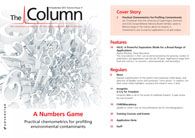GC–MS Authentication Method Developed for World's Most Expensive Coffee Beans
Analytical chemists from Indonesia have developed a metabolomics-based method to determine the authenticity of the world?s most expensive coffee, Asian palm civet coffee (Indonesian Kopi Luwak).1 Currently, there is no reliable, standard method for determining authenticity, making it an ideal target for fraud.

Analytical chemists from Indonesia have developed a metabolomics-based method to determine the authenticity of the world’s most expensive coffee, Asian palm civet coffee (Indonesian Kopi Luwak).1 Currently, there is no reliable, standard method for determining authenticity, making it an ideal target for fraud.
Consumers are willing to pay a high price for the bean because of the taste and aroma thought to result from the unique production process. Coffee berries are fed to the Asian palm civet (Paradoxurus hermaphrodites), a small cat-like mammal, and the “processed” coffee beans are collected from the animal excrement.
Sastia Putri of Osaka University, Japan, told The Column that she initiated the project in collaboration with the Indonesian Coffee and Cocoa Research Institute (ICCRI) and Bandung Institute of Technology, Indonesia. She said: “We selected Kopi Luwak as a research material for several reasons - there are very few scientific reports on Kopi Luwak and, most importantly, there is a serious issue about adulteration and fakes in the market.” She added: “Since this is a highly priced commodity, I think it is very important to prevent such practices because Kopi Luwak is a very important export commodity for Indonesia. Metabolomics technology has been proven to be a powerful tool for quality assessment and authentication of food products.”
Extracts from 21 coffee beans (Coffea arabica and Coffea canephora) from three cultivation areas were sampled and analysed. Gas chromatography coupled with quadrupole mass spectrometry (GC–Q-MS) was performed followed by chemometric data analysis for classifying samples using principle component analysis (PCA). In addition, a cause-and-effect experiment was carried out to determine the effect of the Asian palm civet digestion on different coffee beans.The analysis demonstrated clear differences between Kopi Luwak coffee and “regular” coffee. The team identified citric acid, malic acid, and the inositol/pyroglutamic acid ratio as potential authentication markers.
Putri told The Column: “This is a key stepping stone for the development of a robust authentication procedure of Kopi Luwak in combination with the currently used methods such as visual inspection and taste test. For something that is so expensive, it is important that we make sure the customers get the real deal. It is a shame if Kopi Luwak gets a bad reputation because of the fake products that don’t represent the real taste.” - B.D.
Reference
U. Jumhawan, S.P. Putri, Yusianto, E. Marwani, T. Bamba, and E. Fukusaki, Journal of Agricultural and Food Chemistry61, 7994–8001 (2013).
This story originally appeared in The Column. Click here to view that issue.

Understanding FDA Recommendations for N-Nitrosamine Impurity Levels
April 17th 2025We spoke with Josh Hoerner, general manager of Purisys, which specializes in a small volume custom synthesis and specialized controlled substance manufacturing, to gain his perspective on FDA’s recommendations for acceptable intake limits for N-nitrosamine impurities.












